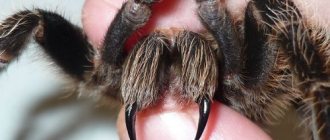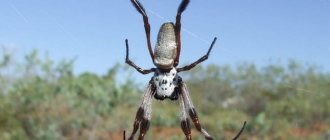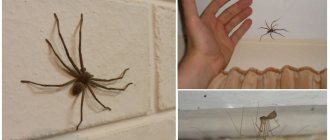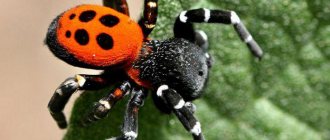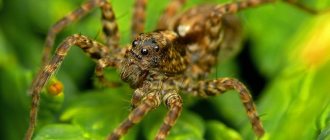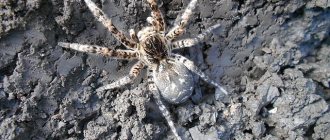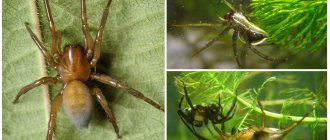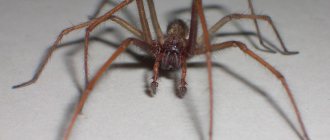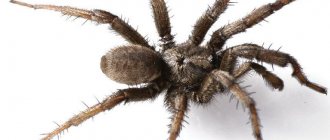Poisonous spiders of Russia
In residential premises there are quite often cobwebs, the proximity of whose owners poses absolutely no threat to humans. But in some regions, the inhabitants of dark corners may be the poisonous spiders of Russia (Figure 1).
Figure 1. Main poisonous species: 1 - cross, 2 - chiracantida, 3 - black widow, 4 - tarantula
Direct contact with them should be avoided; if necessary, contact a specialist. The consequences of bites can seriously affect health, since the poisonous substances in their saliva contain infection or toxic proteins. But how can you determine who bit you and whether it is truly poisonous?
To do this, you should know for sure what photos and types of poisonous spiders in Russia look like:
- Cross spiders
- live in the central regions - pine and spruce, beech forests, in thickets near swamps, usually hang upside down in the center of their web, they owe their name to the characteristic color - a pattern in the form of a cross on the upper part of the belly. - Chiracantids
- they can be found in the grass and shrubs of the middle zone, they do not weave webs and are active at night, the peculiarity of their bite is a characteristic burning pain and swelling of the lymph nodes. - Black widows
are the most dangerous genus of arachnids, in our country it is represented by a single species - karakurt, the color of the animal is black with 13 red spots and a white border, fortunately for humans, they do not show any aggression towards him. - Tarantulas
- their representative, the South Russian Mizgir, has the largest body with short hairs, prefers dry steppes and desert areas, lives in burrows lined with cobwebs.
Safe types
It should be noted right away that absolutely all spiders are poisonous, but only a few will be dangerous to human health - arthropods with highly toxic poison. In this chapter we will look at those whose venom is lethal exclusively to insects.
House spiders
These are perhaps the most famous and most common spiders living in Russia. They got their name because they love to be neighbors with people - they can be found in a private house, in a city apartment, and in outbuildings. This spider usually weaves a funnel-shaped web in dark corners under the ceiling or in more secluded places, for example, somewhere behind a closet.
We suggest you read: The cat licks itself and itches all the time
You can recognize a house spider by the following signs:
- the integument is yellowish-gray or brownish-gray;
- on the back there are usually brown spots arranged in a pattern;
- the legs are dark brown, their length is approximately twice as long as the body;
- The size of females is about 12 mm, the male is no more than 10 mm.
Knitting spiders
There are quite a few species of crocheters, and these spiders are found in Russia more often than others. They are distributed throughout the country and live exclusively in natural conditions. Their trapping nets are circular in shape and have very large meshes. Because of them, at first glance, it may seem that such a web is not suitable for hunting. However, it is not. The net is designed for a specific victim, namely long-legged mosquitoes, which are a favorite delicacy for knitters.
The knitting spider has the following description:
- elongated body;
- legs are long;
- chelicerae are covered with numerous projections;
- Females are usually about 10 mm in size, males are somewhat smaller.
The most poisonous spiders in Russia: photos and names
No matter how much I would like to admit it, dangerous arachnids are far from uncommon in our country, although of them only the female karakurt is really worth fearing. It is the representatives of this species that fall under the category of the most poisonous spider in Russia: the real black widow, the false and the white karakurt (Figure 2).
You can deal with the consequences of bites from other arthropods on your own, although the best thing to do is to seek help from a doctor.
The top poisonous spiders in Russia include:
- Phalanx or solfuga
- despite the fact that it does not have its own poison, its mandibles contain a large number of microorganisms that can lead to infectious infection. - The bag spider or bagworm
does not pose any serious harm to life, but severe pain at the site of its attack may not go away within a couple of days. - The mesh
also does not have dangerous toxins in its saliva, but the likelihood of infection is extremely high. - Mizgir
is not capable of killing a person, but its poison causes an allergic reaction, painful sensations remain for a long time, and severe swelling is characteristic at the site of the wound. - The female karakurt
is the only one listed whose bite can be fatal if the victim is not provided with timely assistance.
Figure 2. The most poisonous spiders in Russia: 1 - phalanx, 2 - bagworm, 3 - net spider, 4 - mizgir, 5 - karakurt
Let's take a closer look at the poisonous spiders in Russia - photos and names:
- Solpuga, solfuga or phalanx
- are active at night, bite quite deeply and only for the purpose of self-defense; if the saliva infected with the infection is not removed from the wound and treated with an antiseptic, it will begin to fester severely. - Crossworts
can also carry infection through their saliva; their distinctive feature is a cross-shaped pattern on the upper side of the abdomen; their females are twice as large as males. - Chiracantids
are wandering hunters and lead an active nocturnal lifestyle, the color of different individuals varies from yellowish to greenish and brown, their bite causes a sharp burning pain, inflammation of the nearest lymph nodes to the lesion;
Karakurt or black widow: regular and false
This is the most dangerous representative of arachnids in the Russian Federation. When talking about what poisonous spiders are found in Russia, one of the first to be named is the true and false black widow (Figure 3).
Figure 3. Regular and false karakurt (black widow)
In both cases, only females, which reach sizes of 15-20 mm, pose a serious threat. The first bite causes severe pain that spreads throughout the body and can lead to death if you do not use a special serum developed against the toxins it contains.
The consequences of a false widow attack are characterized by prolonged pain, increased general body temperature and weakness, which can be observed for two days.
It is difficult to confuse a female common karakurt with anyone else - the black color with characteristic red spots or dots on the belly itself serves as a signal of danger.
The false individual has a uniform black color, sometimes with a brown tint, a pronounced large abdomen and long legs that are lighter in relation to the body; it is often found in Dagestan and often ends up in the homes of local residents.
The white poisonous spider in Russia, which is also a representative of this species, deserves special attention. It is not aggressive in itself, but its venom is very toxic and causes serious complications.
Where and why poisonous yellow spiders appeared near Ufa - expert opinion
Photo: still frame of video from State Television and Radio Broadcasting Company "Bashkortostan"
The capital of Bashkortostan was rocked last week by news of a massive invasion of yellow spiders. As previously reported, the first victims of arthropods appeared in the Ufa village of Nagaevo - one man was hospitalized from a spider bite. Arachnologists have determined that this is a yellow sak - a spider with a yellow belly, a stripe on the back and an orange head with powerful jaws. Its bite is unpleasant, poisonous, but not fatal. Accompanied by severe pain, swelling, nausea and dizziness.
It was also reported that the habitat of these spiders has increased, and they have settled in the republic forever. The Bashinform agency decided to find out from experts where this spider “came” from to the Ufa village, or whether it had been “registered” there for a long time, but not in such large quantities, what to do with it when meeting it, whether it could appear in the capital in the near future .
Director of the Zoological Museum of Bashkir State University Mikhail Krivosheev noted that this species existed in the republic, but in the southern regions.
“I saw him in the Zianchurinsky and Baymaksky districts, but not near Ufa. The number of these spiders simply increased: they laid eggs in one place, and after a few years they crawled five kilometers away. Young individuals can move by flying on spider webs. They have special flying threads. There was a year when tarantulas appeared in the republic, but the fact is that they have always been there, but not in such large quantities. A few years ago, I caught a karakurt (a type of spider from the genus of black widows - author’s note) beyond Sibay, a “native” from Kazakhstan. But, fortunately, or unfortunately, the karakurt does not survive here, but the yellow sak is more adapted to our area,” the expert said. “In the future, with climate change, perhaps Kazakh and Orenburg species, more steppe, may come to our region.”
He added that all spiders are poisonous, but not all are able to bite through human skin, and the yellow sak has an impressive jaw for this.
“In case of possible danger, this spider (for example, when meeting a predator or a person - author’s note) triggers a defensive reaction - it does not attack, but if threatened, it can bite. Of course, the bite is not pleasant for humans,” noted Mikhail Krivosheev.
According to the master of the Bashkir university, arachnologist Alexander Gladkikh, yellow sak is historically present on the territory of Bashkiria, but it was previously found in more southern and arid areas.
“Basically, this spider lives in steppe areas, where it is quite dry and hot, where there is at least some grassy vegetation, and where there is no people. In recent years, the climate has changed a little, it has become hotter, and the time periods have shifted - for two years summer came in July. Habitat shifts are directly related to climate change. Conditions for spiders became more favorable, so they moved a little further from Kazakhstan and the southern part of Europe to Bashkiria, the scientist explained. “It is unlikely that the yellow sak will appear in Ufa, since it prefers uninhabited areas with high vegetation - spiders make nests in the grass.”
In Nagaevo, local residents who saw spiders on the territory of their private homes most likely met male yellow squirrels.
“Male animals travel actively during the breeding season. In search of females, they can travel long distances and even crawl into houses. It’s the males that look terrifying to humans: their front fangs are twice as large as those of females,” added Alexander Gladkikh. - If you do get bitten by a spider, then each case is individual: people with allergies should be wary, but a healthy person can tolerate it normally. It is advisable to disinfect the bite site, take an antiallergic drug and consult a doctor. If a yellow sack is spotted in the house, you should not grab it with your bare hands - it will begin to defend itself. You need to cover it with something on top, for example, a glass jar, and put a leaf underneath - push the spider into the jar and take it outside, away from the house. There is no such means of protection or prevention against spiders; sometimes, however, anti-mite acaricides are used.”
As the Bashinform agency reported, this summer residents of Bashkiria complained not only about poisonous spiders, but also about an invasion of midges in the Iglinsky district, large caterpillars in Agidel and Uchaly, as well as a large number of “night” butterflies in Ufa - pests of many plants.
